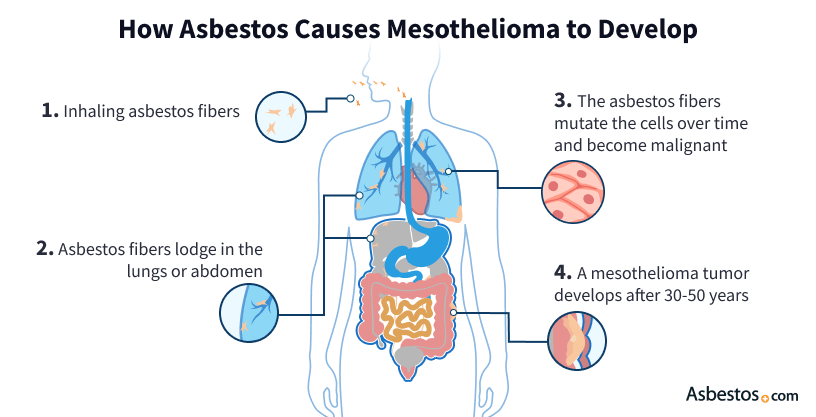John Conway worked as a Navy boiler technician when ships heavily used asbestos. He then worked for the Merchant Marines for 24 years. “I was proud to serve. It was fun, too. It took me around the world three times,” he shares with us.
Mesothelioma Causes & Risk Factors
Asbestos exposure is the main cause of mesothelioma. Small fibers can get stuck in the lining of the lungs or abdomen and damage cells over time, leading to this rare cancer. Occupational, secondary and environmental asbestos exposure also raise the risk of developing mesothelioma.

Expert Take
Dr. Marcelo DaSilva: What causes mesothelioma?
It causes chronic inflammation, and those chronic inflammatory changes in the lung lining, which is the pleura, would then lead to genetic changes in a cell that then gets changed in its DNA into a cancer cell.
There's also talc, which has been most recently associated with development of mesothelioma.

Expert Take
Dr. Marcelo DaSilva: What causes mesothelioma?
It causes chronic inflammation, and those chronic inflammatory changes in the lung lining, which is the pleura, would then lead to genetic changes in a cell that then gets changed in its DNA into a cancer cell.
There's also talc, which has been most recently associated with development of mesothelioma.
What Causes Mesothelioma?
Asbestos exposure is the main cause of mesothelioma. Mesothelioma develops decades after microscopic asbestos fibers are inhaled or ingested. The fibers get trapped in a thin layer of tissue called the mesothelium. This smooth tissue lines the lungs, abdomen, heart and testes.
Learn about your diagnosis, top doctors and how to pay for treatment.
Get Your Free GuideKey Facts About Mesothelioma Causes
- Out of all people with heavy, prolonged exposure to asbestos, 8% to 13% develop mesothelioma.
- Workers exposed to asbestos for many years face the greatest risk of mesothelioma.
- The main mesothelioma risk factor is asbestos exposure. Other risk factors for mesothelioma are occupational and secondhand exposure, age and gender.
Most mesothelioma cases come from asbestos exposure at work or in the military. Some people develop mesothelioma from secondhand contact. Workers have accidentally carried asbestos home on their bodies, clothes or gear. This has put their families at risk.
Other risk factors can raise the chance of cancer in those exposed to asbestos. Doctors have researched other potential causes and risk factors. Some of these possible causes include genetics and exposure to radiation.
How Asbestos Causes Mesothelioma Cancer
Mesothelioma cancer develops after asbestos fibers get stuck in the mesothelium and cause irritation over time. This leads to inflammation and scarring. These fibers can make unstable tiny particles called free radicals that can damage DNA, causing cells to become cancerous.
The duration and intensity of asbestos exposure impact how much DNA damage occurs. More exposure means a greater risk of getting mesothelioma. This is called a dose-response relationship. Even one heavy exposure can lead to a mesothelioma cancer diagnosis decades later.
For example, the toxic dust cloud from the 9/11 attack in New York exposed many people to a single, large-volume exposure to asbestos. Many of these people, including first responders, developed mesothelioma.

Mesothelioma Risk Factors and Secondary Causes
The biggest risk factor for mesothelioma is asbestos exposure. Risk factors are characteristics or behaviors that increase the chances of developing a specific disease. Other risk factors include genetics, age, gender and different types of asbestos exposure.
Mesothelioma Risk Factors
- Age and gender risk: The U.S. Centers for Disease Control and Prevention reports people 65 and older are nearly 13 times more likely to develop mesothelioma than those 54 and younger as of 2021.
- Environmental exposure: Living near asbestos deposits can lead to exposure when sediment or soil is disturbed. This mostly affects people who live close to asbestos mines.
- Family history and BAP1 gene: Studies show mutations in the BAP1 gene raise the risk of mesothelioma for those exposed to asbestos.
- Military exposure: Military bases, housing, vehicles and crafts such as planes and ships used a lot of asbestos, putting veterans at higher risk of exposure and mesothelioma.
- Occupational exposure: Workers in industries that used asbestos heavily have an increased risk of mesothelioma.
- Secondary exposure: Family members of asbestos workers face a risk of exposure from fibers accidentally brought home.
- Simian Virus 40 and radiation: High doses of radiation can increase cancer risk. A link between Simian Virus 40 and mesothelioma risk isn’t confirmed. Research is ongoing.
Exposure to asbestos can happen at work, in older homes, in public buildings and in the environment. Asbestos fibers were used to make products heat resistant, but the fibers can break down and create toxic dust. Workers in commercial and industrial sectors have faced higher exposure risks.
Pleural mesothelioma survivor Terry Latham’s asbestos exposure happened during his 10 years of construction work. Terry tells us he received his diagnosis decades later. Now, he’s one of the longest-living pleural survivors. He shares, “People should know you can get through it, but you can’t stop fighting. Whatever you do, don’t give up.”

We coordinate your care with top cancer centers and guide you through every step.
Get Help NowOccupational Asbestos Exposure
Occupational asbestos exposure is the No. 1 cause of mesothelioma. Among the highest-risk groups are miners and industrial workers, who have long faced significant exposure. Shipyard workers, as well as those in boiler rooms and power plants, are also at risk.
Additionally, legacy asbestos present in older buildings continues to pose a hazard. Construction workers and firefighters encounter risks related to legacy asbestos, especially during renovation, demolition or disaster response. Auto mechanics remain exposed when working with legacy asbestos brakes and clutches.
Military Asbestos Exposure
Veterans get mesothelioma from military asbestos exposure. The U.S. military used asbestos extensively in bases, vehicles, ships and planes. Navy personnel faced higher risks because asbestos was widely applied on ships to reduce the spread of fire. In addition, boiler workers, pipefitters and shipyard workers involved in military shipbuilding and maintenance used asbestos products heavily during their operations.
Navy veteran John Conway tells us he remembers stripping asbestos insulation as part of his job. Decades later, John shares with us that he developed pleural mesothelioma. “It used to look like it was snowing down there,” John recalls about the airborne asbestos fibers he witnessed.
Secondary Asbestos Exposure
Secondary asbestos exposure happens when workers bring tiny asbestos fibers home on skin, clothes, shoes or tools. These fibers can spread into the air and settle on surfaces, putting family members and others close by at risk of breathing asbestos. This take-home exposure is the most common secondary form. It can lead to serious illnesses years later.
For example, barbers and ceramics workers used asbestos-contaminated talcum powder. Taking these fibers home raised the risk of cancer among family members. An engineer exposed to asbestos at work could also carry fibers into a shared office with people who don’t work directly with asbestos, but are exposed as fibers spread in the shared space.
My mesothelioma was caused by my father’s work clothes. He had been a lagger and worked with asbestos all through my childhood. He died of mesothelioma in 1989.
Environmental Asbestos Exposure
Living near asbestos deposits carries a risk of exposure. Tiny fibers can remain airborne in these areas, posing a potential health hazard. The danger is greatest close to old asbestos mines and factories.
Although the risk of disease from living near asbestos mines is lower than from working directly with asbestos, research suggests it accounts for about 3% of all mesothelioma cases. For women, that number rises significantly to 19%.
Some minerals, such as eronite, often develop near asbestos deposits. Eronite isn’t a form of asbestos but contains long, thin fibers similar to asbestos. Because of this, eronite deposits can present an additional exposure risk in affected areas.
Age and Gender Risk for Mesothelioma
Mesothelioma is diagnosed more often in men than in women. Data shows men had an incidence rate 2.4 times higher than women, according to the most recent CDC and SEER statistics from 2020. However, the CDC has also reported a recent sharp rise in cases of mesothelioma in women.
Women’s asbestos exposure historically came mainly from secondary exposure or from living near asbestos sites. Today, increased occupational exposure to legacy asbestos and use of asbestos-contaminated products like talc may be responsible for the rise in incidence. Better medical awareness also has helped doctors identify more cases in women than before.
Age is another important factor in mesothelioma risk. Most people receive their diagnosis between ages 75 and 79, reflecting how long the disease takes to develop after exposure. The latency period for mesothelioma is 20 to 60 years. However, cases have been found in teens and young adults in their 20s as a result of early-life asbestos exposure.
One piece of advice who I would give to a woman who has been recently diagnosed with mesothelioma is this. Let me encourage you for a moment. You have access to treatments, different treatments. You have the right to get a second opinion. You have the right to ask questions. You have the right to find the specialist who you want for your journey.
Family History and BAP1 Gene
Some genetic factors can increase a person’s chance of getting mesothelioma after asbestos exposure. Mesothelioma isn’t inherited like some other diseases. However, a change or mutation in a gene called BAP1 can make someone more likely to develop mesothelioma if they come into contact with asbestos.
Genes carry instructions for how our bodies work, and mutations are small differences in those instructions. Certain mutations in the BAP1 gene can affect how cells grow and repair themselves. These changes are often found in mesothelioma tumors and can help explain why people with this mutation are at higher risk.
Because of this discovery, doctors now suggest that testing for BAP1 gene mutations should be part of diagnosing mesothelioma. This testing can help patients and their doctors better understand the disease and guide treatment choices.
Simian Virus 40 & Radiation
Researchers have found some cancer tumors contain Simian Virus 40, also known as SV40. However, there is no evidence that SV40, a virus found in humans and monkeys, causes mesothelioma. Scientists continue to study SV40 to understand if it plays any role in the disease.
Workers on nuclear submarines and in propulsion plants faced widespread asbestos exposure from insulation and fireproofing, putting them at higher risk for mesothelioma. Research indicates that the high doses of radiation these workers received on such vessels may add to their mesothelioma risk.
This radiation exposure differs greatly from the low levels people receive from medical imaging, such as X-rays and CT scans. Radiation from imaging scans has not been linked to mesothelioma risk.
How to Lower Your Risk of Mesothelioma
Employers must provide safe working conditions to prevent mesothelioma. They’re responsible for keeping workplaces free of asbestos, providing personal protective equipment and conducting proper training. If workers notice safety violations, they should talk with their union representatives or file a report with the Occupational Safety and Health Administration. OSHA then investigates.
The public can lower its risk by avoiding asbestos products, including consumer goods, home building materials and automotive parts. Older homes, salvaged and vintage materials and classic auto parts can contain legacy asbestos and put DIY-ers at risk.
Tips to Reduce Asbestos Exposure
- Don’t wear clothing, footwear or other work gear that could carry asbestos fibers home.
- Take care when buying vintage, antique or upcycled items that might contain asbestos.
- Use a qualified asbestos abatement company to test for and remove asbestos safely from your home.
- Choose talc-free cosmetics and personal care products.
- Report any asbestos exposure at work to OSHA.
- Talk with your employer about asbestos risks and workplace safety policies.
If you’ve already been exposed and worry about your health, our Patient Advocates can connect you with a doctor to screen for mesothelioma. Early detection improves treatment options.
See your doctor promptly if you experience symptoms of mesothelioma such as shortness of breath, chest pain or abdominal discomfort. Patient Advocates can connect you with specialists who offer expert care.
Expert Takeaways for Mesothelioma Causes
- A 2023 study in the journal Critical Reviews in Toxicology finds risks across jobs and asbestos types. The peritoneal mesothelioma rate for all jobs studied was 70 to several hundred fold higher for amosite and crocidolite.
- Patients and families should be aware of potential asbestos exposure risks, particularly in industries like textile work, construction, manufacturing and shipbuilding.
“Asbestos exposure is the primary cause of mesothelioma. Still, there is no predictability as to who or when the exposure will progress to the development of mesothelioma and where it will manifest in the body.”
Questions Our Patients Advocates Are Commonly Asked
We asked our Patient Advocates about the questions people ask when they call us about the cause of mesothelioma. Here are some common questions and helpful answers.
- How much asbestos exposure can cause mesothelioma?
-
Any amount of asbestos exposure can cause mesothelioma, but prolonged or repeated exposure increases the risk. There’s no safe level of asbestos exposure. Even short-term contact can lead to mesothelioma decades later.
- How likely am I to develop mesothelioma?
-
Mesothelioma is a rare form of cancer. There were about 2,800 new cases in the U.S. in 2021, the most recent year of available data. There is about 1 new case per 100,000 people annually. Mesothelioma is very rare in people without any known asbestos exposure. High-risk occupations for asbestos exposure include construction, power generation, shipbuilding and industrial work.
- How long does it take for mesothelioma to develop?
-
Asbestos can change healthy cells into cancer cells decades after exposure. The fibers start an inflammation that slowly harms genes and can lead to cancer 20 to 60 years later. After tumors form, mesothelioma can swiftly advance to stage 3 or 4. Symptoms may appear after this progression.
- Does smoking cause mesothelioma?
-
No, smoking does not cause mesothelioma. The primary cause of mesothelioma is exposure to asbestos fibers. Smoking and tobacco use are linked to lung cancer and other cancers. But they are not linked to a higher risk of mesothelioma.
Answered By: Anna Nowak, internationally renowned asbestos researcher and mesothelioma advocate.






